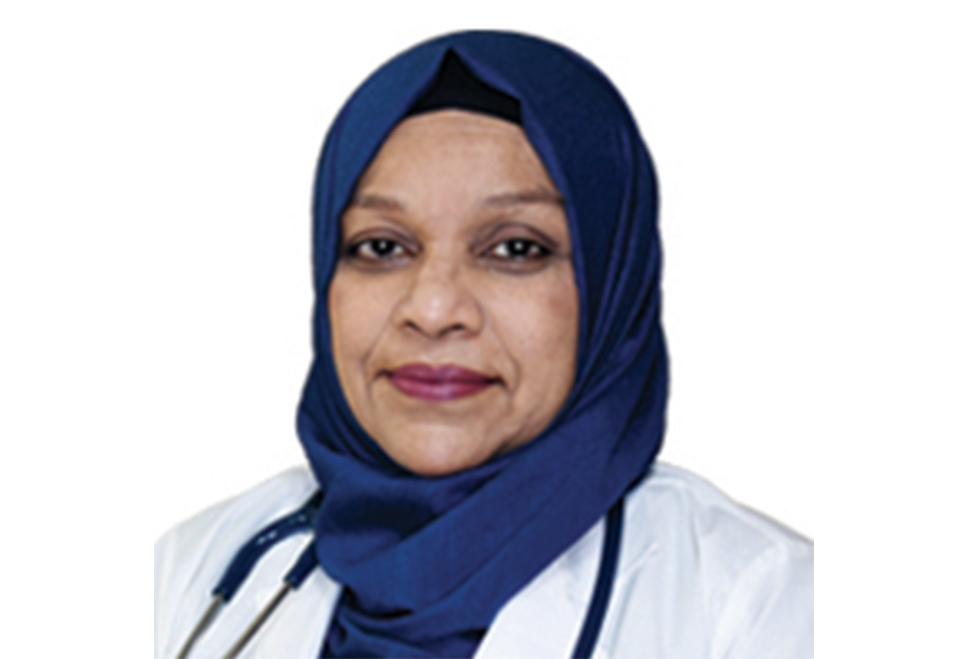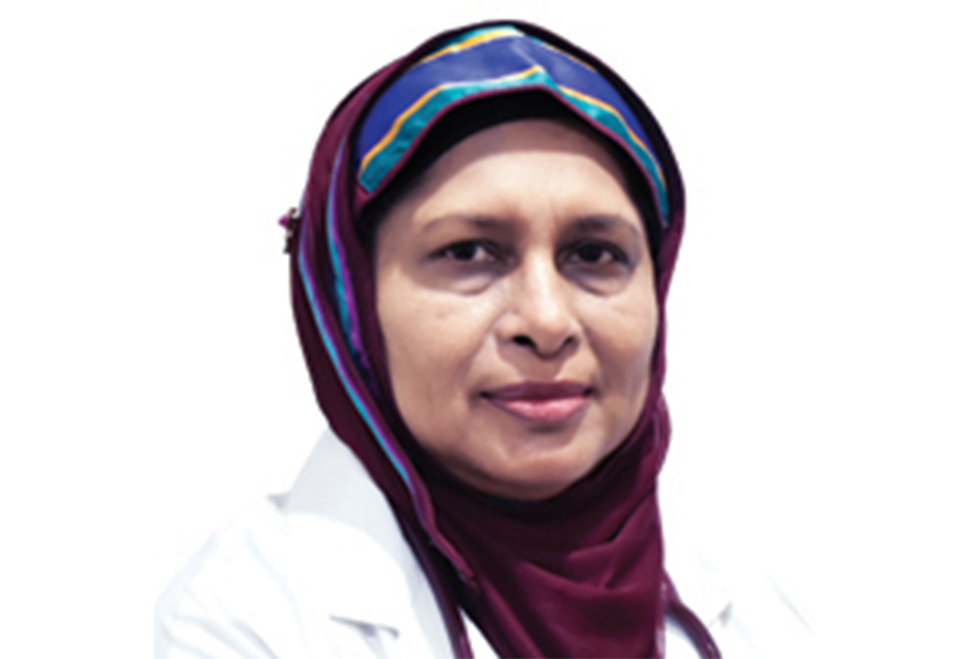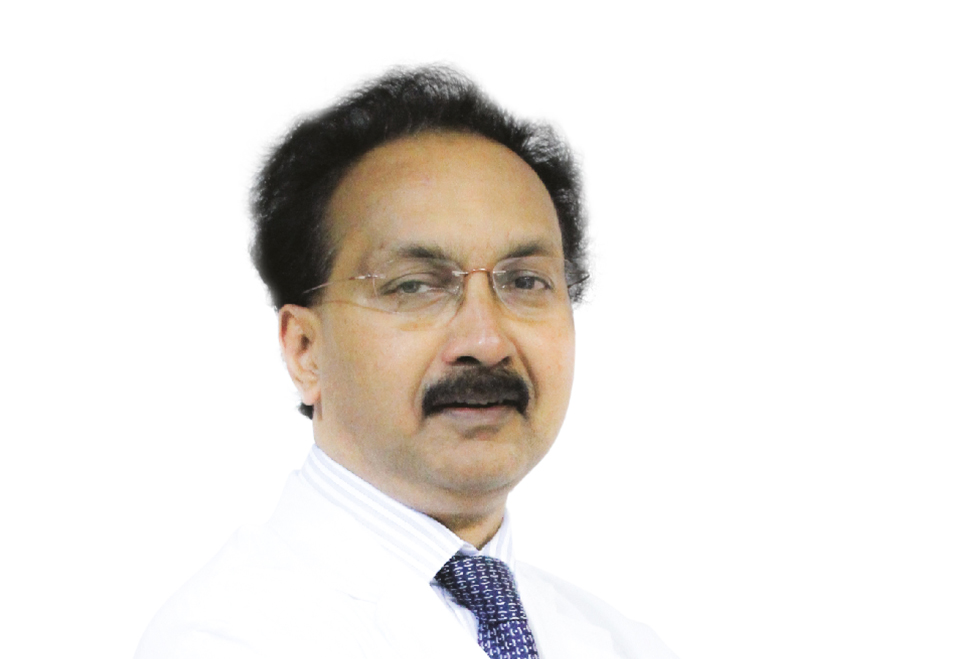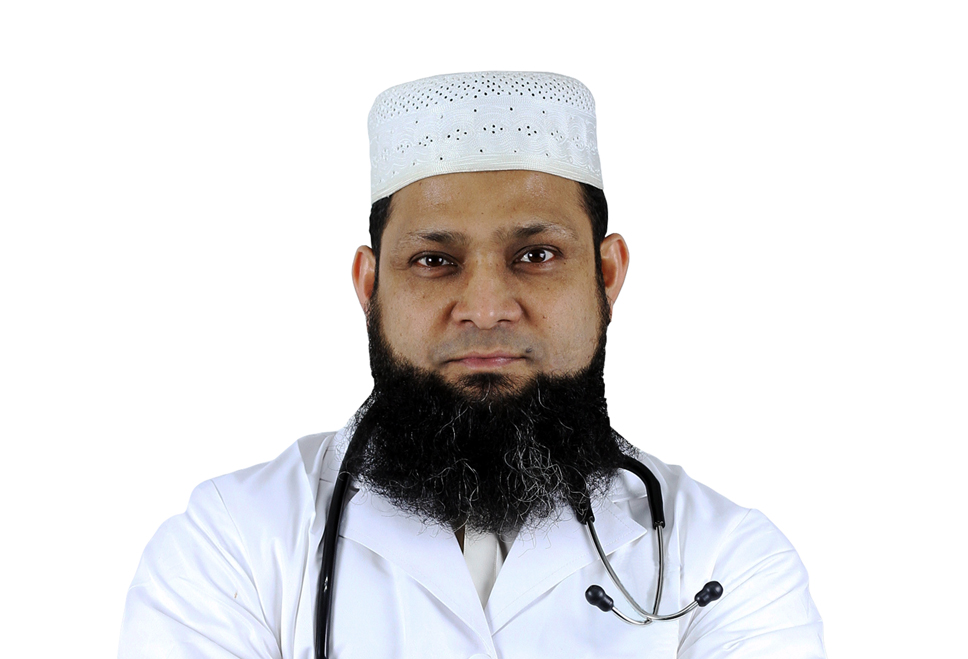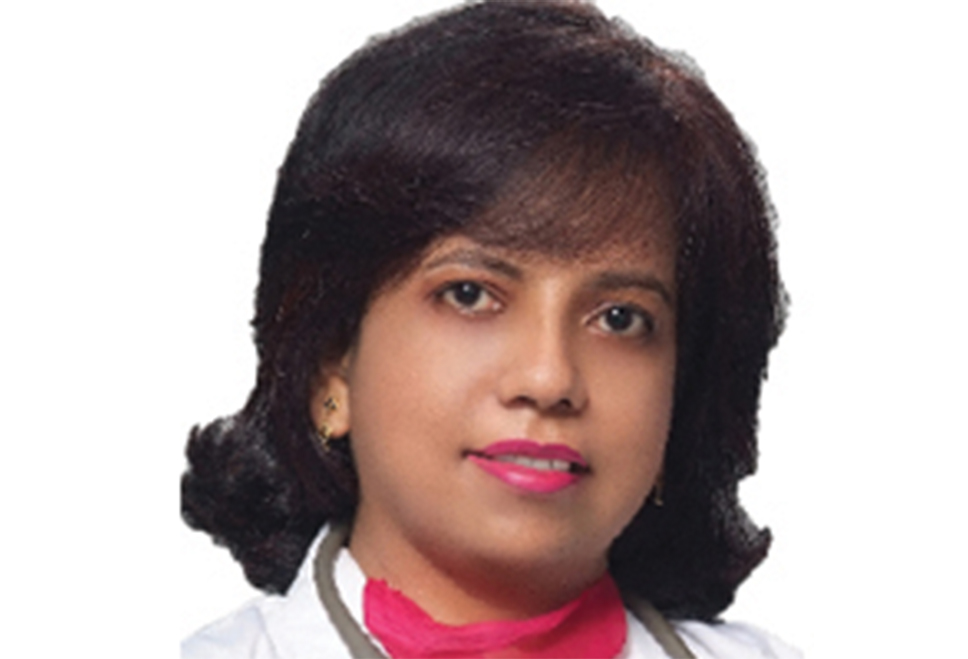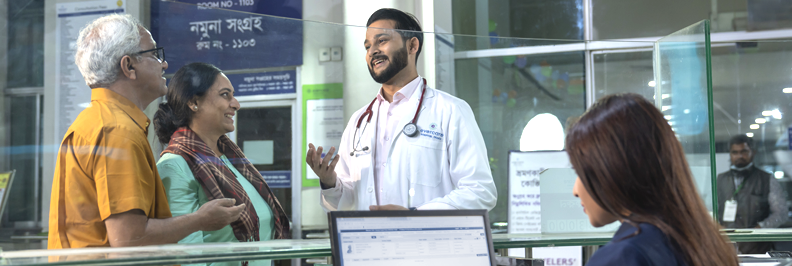Gastroenterology & Hepatology
Gastroenterology & Hepatology Centre at Evercare Hospital Dhaka
Department of Gastroenterology & Hepatology is devoted to the clinical care of patients with gastrointestinal and liver disorders. The department is home to excellent patient care, and our specialists employ the most advanced diagnostic and therapeutic endoscopy services to ensure the best outcomes for each patient. Working closely with a dedicated staff that includes doctors, technologists, nurses, dietitians and more, our care is unsurpassed with the kind of quality and compassion you can expect from a leader in healthcare.
CONSULTATION & APPOINTMENTS
The Department provides consultation services in level-8 (OPD) through highly qualified and experienced Gastroenterology & Hepatology Consultants, who carefully evaluate each patient. After diagnosing patient’s condition, our Consultants discuss available treatment options and recommend the most effective treatment.
List of Doctors
We can help you choose top specialists from our pool of expert doctors, physicians and surgeons.
Conditions Treated
The department manages a variety of gastrointestinal and liver disorders, including peptic ulcer disease, gastro-oesophageal reflux disease, gastrointestinal bleeding, functional gastrointestinal disorders, inflammatory bowel disease, pancreatico-biliary diseases, acute and chronic liver disease, as well as gastrointestinal and liver malignancies.
Evercare Hospital Dhaka introduces a revolutionary endoscopy alternative
Evercare Hospital Dhaka the first JCI accredited hospital in Bangladesh is proud to present a brand new endoscopy technology in the form of a small capsule. This tiny device has four laterally oriented cameras and 16 independently controlled LEDs that provide a crystal clear 360º panoramic image of the mucosa and ensure a 32% higher diagnostic yield than compared to traditional endoscopies.
- Pain Free
- No Hospital Stay
- No Anesthesia Required
GASTROINTESTINAL (GI) ENDOSCOPY
- WHAT IS GI ENDOSCOPY?
- ENDOSCOPY UNIT
- GI ENDOSCOPY PROCEDURES OFFERED
- DURING GI ENDOSCOPY & COLONOSCOPY
- AFTER GI ENDOSCOPY & COLONOSCOPY
WHAT IS GI ENDOSCOPY?
Gatrointestinal Endoscopy is the inspection of the gastrointestinal tract using a flexible or rigid instrument called an endoscope, with a camera and light at one end and a viewing monitor or eyepiece at the other. The endoscope is usually introduced through a natural opening, such as the mouth or anus.
Images of the inside of the patient’s body can be seen on a screen; the whole endoscopy is recorded so that doctors can check it again. An endoscopy is a non-invasive medical procedure used for investigation or diagnosis, biopsies and foreign object retrieval, without the need for surgery. Using special tools during endoscopy also allows the doctor to treat certain problems in the patient’s organ system.
ENDOSCOPY UNIT
Evercare Hospital Dhaka has state-of-the-art Endoscopy Unit, located in level-8 of the hospital, which is fully equipped to offer comprehensive diagnostic, therapeutic and interventional endoscopic procedures of the gastrointestinal tract (as well as bronchoscopy). Endoscopy Unit is furnished with the latest procedure and monitoring equipment for endoscopy procedures, which provides maximum accuracy, quality and safety for patients.
Our procedures are performed utilizing the services of expert doctors and medical team, as well as anesthesiologists to provide intravenous sedation to make the procedure as comfortable as possible. The Endoscopy Unit provides patients and their families with the highest level of comfort, privacy and convenience, before, during and after examinations. After the procedure, the patient can rest for a few hours in our Day Care Unit, located opposite the Endoscopy Unit.
GI ENDOSCOPY PROCEDURES OFFERED
The following Gastrointestinal Endoscopic procedures are offered by the department:
Endoscopy
We offer a number of endoscopy packages for examination of specific parts of the GI tract, guided by endoscope. The following packages are offered:
- Endoscopy – side-viewing
- Endoscopy & CLO test
- Endoscopy & Polypectomy of GI – multiple
- Endoscopy of UGI & LGI – combined
Gastroscopy or EGD (esophagogastroduodenoscopy)
Gastroscopy or EGD is the endoscopic examination of the upper GI, i.e. the mouth, oesophagus, stomach and duodenum.
Colonoscopy
Colonoscopy is the endoscopic examination of the rectum and colon to the ileocaecal valve. We offer normal colonoscopy, as well as high resolution colonoscopy. We offer a number of colonoscopy packages:
- Colononoscopy – limited to the right
- Colononoscopy & polypectomy
- Colonoscopy via Fl
- High resolution colonoscopy
Enteroscopy
Enteroscopy is the endoscopic examination of the small intestine (small bowel).
Endoscopic Polypectomy
During the course of EGD or colonoscopy, a polyp may be found. Polyps are abnormal growths of tissue which vary in size from a tiny dot to several centimetres. The removal of these polyps endoscopically is called Endoscopic Polypectomy. Depending on the size, shape and location of the polyp, the physician may feel that removal is indicated.
Polyps are usually removed because they can be the source of rectal bleeding or may contain cancer. Although majority of polyps are benign (non cancerous), some may contain a small area of cancer or may develop cancer if left untouched. Removal of polyps is therefore an important means of prevention and cure of cancer of the GI tract.
We offer the following polypectomy packages:
- Endoscopic polypectomy
- Endoscopic polypectomy – add-on
- Colononoscopy & polypectomy
- Endoscopy & Polypectomy of GI – multiple
Sigmoidoscopy
Sigmoidoscopy is the endoscopic examination of the rectum and lower part of the colon.
ERCP (Endoscopic Retrograde Cholangio-Pancreatography)
ERCP combines the use of endoscopy and fluoroscopy to diagnose and treat certain problems of the biliary or pancreatic ductal systems. We offer a number of ERCP combinations:
- Diagnostic ERCP
- ERCP with biliary stenting
- ERCP with nasal biliary
- ERCP with papillotomy
- ERCP with stone extraction
Paracentesis
Paracentesis is the endoscopic removal of fluid that has accumulated in the abdominal cavity (a condition called ascites). Ascites may be caused by infection, inflammation, abdominal injury or other conditions, such as cirrhosis or cancer.
The fluid is removed using a needle inserted through the abdominal wall and then sent to the lab for analysis to determine the cause of the fluid build-up. Paracentesis may also be done to drain the fluid to help cancer or chronic cirrhosis patients ease their pain.
We offer two Paracentesis packages:
- Paracentesis – therapeutic
- Paracentesis (abdominal, bed side) – diagnostic
Percutaneous endoscopic gastrostomy (PEG)
PEG is a surgical procedure for placing a tube for feeding without having to perform an open operation on the abdomen (laparotomy). It is used in patients who will be unable to take in food by mouth for a prolonged period of time. A gastrostomy, or surgical opening into the stomach, is made through the skin using an endoscope, which is passed orally into the stomach to assist with the placement of the tube and secure it in place.
Endoscopic Sclerotherapy (EST)
Endoscopic Sclerotherapy is a treatment for oesophageal bleeding that involves the use of an endoscope and the injection of a sclerosing solution into veins. It is used for esophageal varices, enlarged or swollen veins on the lining of the esophagus which are prone to bleeding.
We offer the following packages for Sclerotherapy:
- Endoscopic Sclerotherapy (EST)
- Endoscopic Sclerotherapy (EST) – minor
- Endoscopic Sclerotherapy (EST) of ulcer
Endoscopic mucosal resection (EMR)
Gastrointestinal endoscopic mucosal resection (EMR) is a procedure to remove cancerous or other abnormal tissues (lesions) from the digestive tract.
Endoscopic placement of tubes
We offer the placement of different tubes internally within the gastrointestinal tract, guided by endoscope. These include:
- Endoscopic placement of nasojejunal feeding tube (NJFT)
- Endoscopic placement of Ryles tube
- Endoscopic placement of Sengstaken tube
Endoscopic pseudocyst drainage
Some pancreatic pseudocysts will require endoscopic drainage. Endoscopic drainage represents an efficient modality of drainage with a high resolution rate and lower morbidity and mortality than the surgical or percutaneous approach.
Endoscopic variceal (EV) banding
Endoscopic variceal banding is used as a treatment for variceal bleeding. During variceal banding, a doctor uses an endoscope to place an elastic ring that looks like a rubber band around an enlarged vein. Banding the vein in this manner will cut off blood flow through the vein.
Variceal banding has been shown to be as effective as sclerotherapy in treating episodes of bleeding, and it has fewer complications. Variceal banding is often done several times to control the varices and prevent bleeding. The doctor will check the varices every 3 to 12 months after that for the rest of the patient’s life.
Endoscopic variceal ligation (EVL)
EVL is an effective means of treating esophageal varices endoscopically with fewer complications than endoscopic sclerotherapy (ES). Endoscopic variceal ligating devices are placed on the tip of standard endoscopes. The device has a soft sheath portion that fits over the tip of the endoscope and a hard plastic portion. There is also a separate hard plastic part over which the bands are stretched and ready to be deployed.
Endoscopic Biopsy
Endoscopic biopsy is a biopsy obtained by instruments passed through an endoscope or by a needle introduced under endoscopic guidance. A biopsy is basically the removal and examination, usually microscopic, of tissue from the living body, performed to establish precise diagnosis.
Percutaneous liver biopsy
Liver biopsy, guided by endoscope, is done using a long needle inserted between two of the right lower ribs to remove a sample of liver tissue. The tissue sample is sent to a laboratory and looked at under a microscope to see if there are any liver problems. A liver biopsy may be done when liver blood tests are abnormal. A liver biopsy can also be done to find the cause of jaundice or to check on cirrhosis, hepatitis, or liver cancer.
Endoscopic Foreign Body Removal
This involves the removal of foreign bodies in the gastrointestinal tract through endocopy.
Gastrointestinal Dilations
A gastrointestinal dilation procedure is performed through direct endoscopic visualization and involves a balloon being used to open narrowed areas or strictures in the digestive tract, which are most frequently located in the oesophagus and colon. Multiple dilations may be performed if the stricture has not been successfully opened. We perform the following dilations:
- Colon Dilatation
- Oesophageal Dilatation
- Dilation for achalasia (condition where muscles of the lower oesophagus grow weak and do not open properly during swallowing)
- Endoprosthesis
Endoprosthesis is the artificial replacement of body part entirely inside the body. We offer the following endoprosthesis:
- Endoprosthesis – colon
- Endoprosthesis – upper GI
Endoscopic GI cleansing
This involves cleansing of the gastrointestinal tract, guided by endoscope.
APPOINTMENTS FOR ENDOSCOPY
For further information and appointments for endoscopy, please contact us at the following numbers: 10678
PREPARATION FOR GI ENDOSCOPY & COLONOSCOPY
- Eat plain rice with dal, fish and take plenty of water the previous night for the Endoscopy or Colonoscopy packages
- Don’t take any meat, vegetable or iron tablet the previous day
- Take two (02) Duralux tablets the previous night after dinner
- Bring fleet Phospa Soda 45 ml. on the examination day
- Come with fasting
DURING GI ENDOSCOPY & COLONOSCOPY
Gastrointestinal endoscopies (except colonoscopy) involve the insertion of an endoscope through the mouth. For colonoscopy, the endoscope is inserted through the rectum. An endoscopy or colonoscopy procedure can take from 20 minutes to an hour, depending on the patient’s situation.
During GI Endoscopies
During endoscopy procedures, the patient will be asked to lie down on a table on his/her back or side. Monitors often will be attached to the patient’s body to allow the medical team to monitor patient’s breathing, blood pressure and heart rate during the procedure. The patient may receive an intravenous sedative medication which helps in relaxing during the endoscopy.
The doctor may spray an anaesthetic in patient’s mouth to numb the throat in preparation for insertion of the long, flexible endoscope tube, which will be used to see the digestive tract. Then the endoscope is inserted in patient’s mouth. The doctor may ask the patient to swallow as the scope passes down his/her throat. Patient may feel some pressure in the throat, but shouldn’t feel pain. The endoscope doesn’t interfere with patient’s breathing.
The doctor then passes the endoscope down patient’s oesophagus toward the stomach. A tiny camera on the end of the endoscope transmits images to a video monitor in the exam room. If abnormalities are found in the digestive tract, the doctor may record images for later examination. To help the endoscope move through the upper digestive tract, gentle air pressure may be fed into patient’s oesophagus.
This inflates the digestive tract so the endoscope can move freely and the folds of the digestive tract are more easily examined. But the air can also create a feeling of pressure or fullness. If there’s a need to collect a tissue sample or remove a polyp, the doctor will pass special surgical tools through the endoscope. The doctor watches the video monitor to guide the tools. When the exam is finished, the endoscope is slowly retracted through the patient’s oesophagus and back out through his/her mouth.
During Colonoscopy
During a colonoscopy, the patient will wear a gown but likely nothing else. Sedation is usually recommended. Sometimes a mild sedative is given in pill form. In other cases, the sedative is combined with an intravenous pain medication to minimize any discomfort. The patient will begin the exam by lying on his/her side on the exam table, usually with knees drawn toward the chest.
The doctor will insert a colonoscope into the patient’s rectum. The scope — which is long enough to reach the entire length of your colon — contains a fibre-optic light and a channel that allows the doctor to pump air into the colon. The air inflates the colon, which provides a better view of the lining of the colon. When the scope is moved or air is introduced, the patient may feel abdominal cramping or the urge to have a bowel movement.
The colonoscope also contains a tiny video camera at its tip. The camera sends images to an external monitor so that the doctor can study the inside of the colon. The doctor can also insert instruments through the channel to take tissue samples (biopsies) or remove polyps or other areas of abnormal tissue. When the examination is complete, the colonoscope is slowly retracted back through the same channel.
AFTER GI ENDOSCOPY & COLONOSCOPY
After GI endoscopy procedures, the patient will be taken to our Day Care Unit (opposite the Endoscopy/Bronchoscopy Unit) to sit or lie quietly. Patient may stay at this unit for an hour or so, depending on his/her situation. This allows the health care team to monitor the patient as the sedative begins to wear off. Once the patient is at home, he/she may experience some mildly uncomfortable signs and symptoms after endoscopy, such as:
- Bloating and gas
- Cramping
- Sore throat or rectum
- After colonoscopy, the patient may also notice a small amount of blood with his/her first bowel movement after the exam. Usually this isn’t cause for alarm. The patient should consult the doctor if he/she continues to pass blood or blood clots or if there is persistent abdominal pain or a fever of 100 ºF (37.8 ºC) or higher.
These signs and symptoms will improve with time. If the patient is concerned or quite uncomfortable, he/she should call the doctor. Take it easy for the rest of the day after the endoscopy. Patient may feel alert, but his/her reaction times and judgment are delayed after receiving a sedative.
IMPORTANT POINTS ABOUT TESTS/PROCEDURES/SURGERIES, YOUR REPORTS & BILLING ENQUIRIES
- Tests/Investigations:
- To schedule a test/investigation, please call the relevant OPD front desks.
- Your lab investigation samples are to be deposited in the Sample Collection Room located in the hospital’s atrium, which is open on working days (Saturday-Thursday) from 7.00 am to 10:00 pm, and on Fridays and holidays from 7.00 am to 3.00 pm.
- Your investigation reports can be collected from Report Delivery Room by showing the receipt of payment. The hospital shall not be responsible for reports not collected within 30 days after the tests were done. Report Delivery Room is also located in the hospital’s atrium, and is open on working days (Saturday-Thursday) from 8.00 am to 8.30 pm, and on Fridays and holidays from 9.00 am to 5.00 pm.
- You will not be able to collect your investigation reports without your receipt of payment. If you have lost your receipt, you may collect a duplicate copy from our Billing Executives (Corporate Desk, Atrium – level 1).
- You can request duplicate copy of your investigation reports from the Report Delivery Room, inclusive of BDT 100 additional charge.
- Procedures & Surgeries:
- If you are interested in undergoing a procedure or surgery, please see our relevant Consultant first.
- To search for a Consultant, go to Find a Consultant page and for appointments, go to Make an Appointment
- In-patient Reports
- A Discharge Summary is provided to a patient upon his/her discharge from the hospital. A discharge summary is a summary of the events during hospitalization of the patient. It outlines the patient’s chief complaint, the diagnostic findings, the therapy administered and the patient’s response to it, and recommendations on discharge.
- To request for detailed in-patient medical reports or to make an insurance claim, refer to our Medical Report
- For queries on charges, contact our Billing Department (Corporate Desk, Atrium – level 1) or call/e-mail our Billing Executives:
| Mr. Taslimur Rahman: AGM – Financial Operation Phone : +88-02-8431661-5; Ext-1353 (From 9 am to 5 pm –Except Holidays) E-mail: taslimur.rahman@evercarebd.com |


